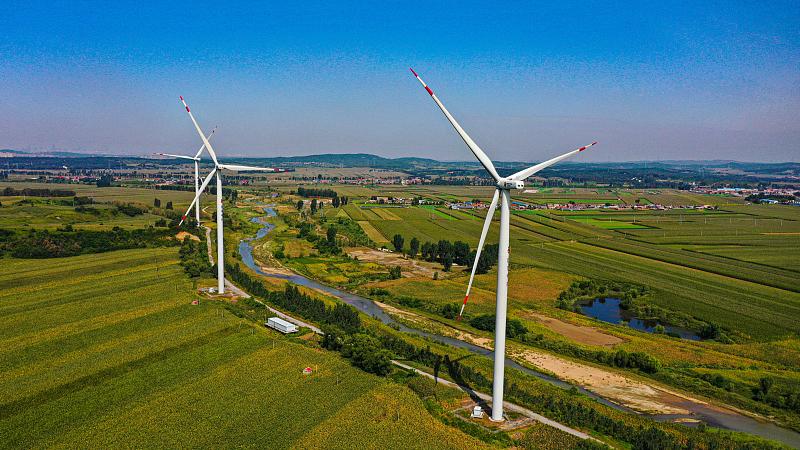
Wind power project in Shenyang, China, September 6, 2022. /CFP
Wind power project in Shenyang, China, September 6, 2022. /CFP
Editor's note: Djoomart Otorbaev is the former prime minister of the Kyrgyz Republic, a distinguished professor of the Belt and Road School of Beijing Normal University, and a member of the Nizami Ganjavi International Center. The article reflects the author's views and not necessarily those of CGTN.
So far, 196 Parties (195 countries and European Union) have adopted the Paris Agreement on Climate Change, signed on December 12, 2015. Member countries agreed to reduce greenhouse gas emissions, take climate change adaptation measures, and develop and share low-carbon technologies. Its main goal was to keep the global temperature below 2, preferably to 1.5 degrees Celsius this century. According to the International Energy Agency (IEA) estimates, the share of energy from renewable sources should increase from about 10 percent to 60 percent, mainly due to solar, wind, nuclear and hydropower, and the share of fossil fuels will decrease from almost 80 percent to about 20 percent.
McKinsey analysts have calculated that to achieve carbon neutrality by 2050, the global cost for humanity could reach a whopping $275 trillion, with an annual investment of around $9.2 trillion.
The restructuring of the world economy to carbon-free and low-carbon technologies will require the creation of new principles for generating, transmitting and distributing clean energy. It will require developing and applying renewable energy sources, which should change the world's economy. Generating energy efficiently from wind turbines and solar panels, as well as producing hydrogen and batteries for vehicles, will require the widespread adoption of new technologies. Producers of new materials will take the place of coal and oil suppliers in global trade. Today's world will witness a global transition from fuel-intensive to material-intensive energy systems. Significant volatility in the traditional energy markets currently underway will further accelerate this transition. The modern world is in a large-scale and global transition from fuel-intensive to material-intensive energy systems.

Solar panel in Henan, China, September 23, 2022. /CFP
Solar panel in Henan, China, September 23, 2022. /CFP
According to the Argonne National Laboratory, a typical automotive lithium-ion battery (for example, NMC532) can contain about 8 kg of lithium, 35 kg of nickel, 20 kg of manganese and 14 kg of cobalt. Wind turbines require large amounts of iron, copper and aluminum, while solar panels use copper, silicon, silver and zinc. An onshore wind farm will require nine times more mineral resources than a gas-fired power plant of the same capacity, and an environmentally friendly electric car will require six times more mineral resources than a conventional car. Transmission electrical networks need vast amounts of copper and aluminum. Depending on the technology used, electrolysers and fuel cells in hydrogen production should include nickel or metals of the platinum group. Copper is an essential element for almost all technologies related to electricity.
With the implementation of this revolutionary energy transition, aluminum will become the most used metal by weight. Still, in percentage terms, its annual consumption in this sector will be only a few percent of today's production. World Bank experts have estimated that between 2018 and 2050, it will be necessary to extract over 3 billion tons of various minerals and metals and use them in solar, wind, geothermal energy and energy storage systems. It is assumed that the annual consumption of three of them – graphite, lithium, and cobalt – by 2050 will have to increase by more than four folds from the level of 2018.
According to the International Energy Agency, batteries and electric vehicles are forecast to account for about half the demand for new materials, and the need for those materials will grow more than 30 times in twenty years. By weight, the market for minerals in 2040 will be dominated by graphite, copper and nickel, but its consumption will not increase much. At the same time, the highest growth rate of consumption will be observed for cobalt, graphite, and especially lithium, which should rise more than 40 times .
Will the sharp increase in demand for new materials required for large-scale renewable energy production become a problem? In some cases, it will not be difficult to increase output. For example, the silicon needed for solar cells is abundant on Earth. Technologies for extracting and enriching this material, which has been actively used in microelectronics for decades, are constantly being improved. But producing materials such as neodymium for wind turbines, lithium and cobalt for batteries, and the ubiquitous copper will require additional significant financial contributions from investors and technological efforts from geologists and materials scientists.
In this regard, it is not difficult to predict that the prices of these materials will rise, and a sharp increase in their production will magnify the negative impact on the environment. Additional challenges compared to the supply of fossil fuels will be the complexity of supply chains for clean energy technologies, as their supply chains are much more geographically concentrated. But despite these factors, there is no alternative to renewable energy sources. All materials needed to save the planet must be mined, enriched, and used to produce clean energy.
(If you want to contribute and have specific expertise, please contact us at opinions@cgtn.com. Follow @thouse_opinions on Twitter to discover the latest commentaries in the CGTN Opinion Section.)

